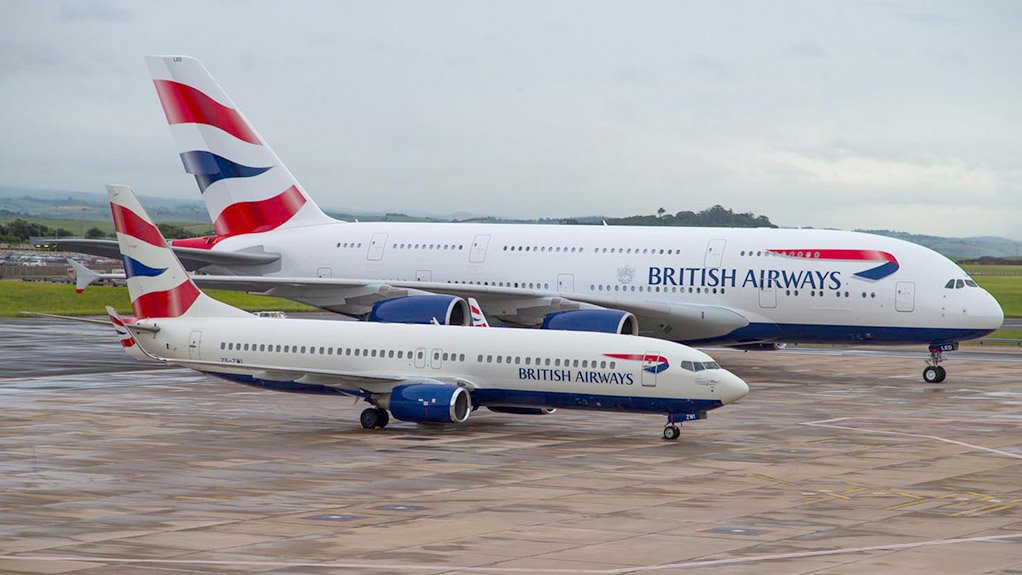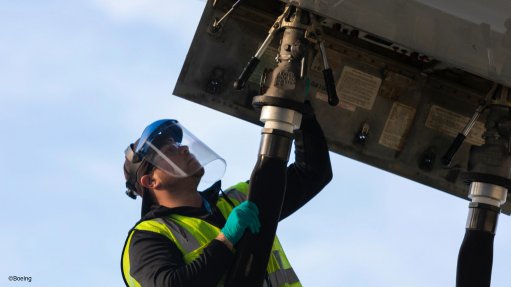Rand decline causes SA airline turbulence


NEXT LEVEL OF EFFICIENCY A Comair Boeing 737-800 stands in front of a BA Airbus A380
Photo by British Airways
The number one challenge facing the South African airline industry is the devaluation of the rand. “It’s a big challenge,” affirms Comair CEO ErikVenter. “It has devalued by about 25% over the past year. This has had immediate impacts on fuel prices. It also has an impact on maintenance and on various other costs relating to foreign suppliers, such as our global distribution charges.”
The slide in the rand increases local fuel prices even when the oil price stays stable in dollar terms. When the dollar oil price goes up, local airlines are doubly hit.
“The only way to deal with this is to continue pursuing further efficiencies,” he notes. “And some of the increases have to be passed on to the customer, unfortunately. The consequence of this is that we have seen a continued shrinkage of the domestic market. It shrank by around 5% in the prior 12-month period and it is still shrinking by 5%, so it’s becoming a compounding effect now, which is of some concern.”
Nevertheless, the cost escalation has to be dealt with. Passing it on to the customer is not and never has been a sole solution. Since 2001, the cost index for domestic South African airlines has risen by 168%, while the consumer price index has increased by 98%. Yet the air fares for Comair’s two brands – British Airways (BA) and Kulula – have gone up by only 30% during the same period. (Comair operates the BA brand in South and Southern Africa as a franchise from the UK airline.)
“The only solution is, therefore, to increase the efficiency of the operation,” he reports. “Now, the most obvious way to do this is to try to spread more of the cost over a larger base of customers. When you’re sitting with a situation with a stagnant or shrinking market, you’re not simply going to pick up a large volume of customers, so, therefore, you have to restructure your fleet, the size of your aircraft, the efficiency of your aircraft, to deal with the matter. And, for the past 15 years or so, Comair has been slowly upgrading the size of its aircraft, the efficiency of its aircraft, and that cycle of constantly upgrading aircraft is the crux of Comair’s survival in this market. So we’re now putting the first [Boeing] 737-800 into service with our BA fleet.”
The first of the new 737-800s has already been in service for a few months. This aircraft delivers a 6% reduction in fuel consumption, compared with the old Boeing 737-300 models it is replacing. Yet it also provides about 40% more seating. (The 737-800 has a passenger capacity of up to 165, in contrast with up to 117 in the 737-300.) “And that really is the next step in moving our BA fleet to the next level of efficiency. “That makes a really big difference – your cost per seat is coming down by around 46%. It sounds great, but when you were hit by a 25% fuel increase last year – we had similar increases in 2012 – that total saving per seat gets sucked up very, very fast. But it does mean we’ve managed to stay in business when we’ve seen the massive cost escalation and the relatively small air fare escalation.”
However, the weakness of the rand against most major currencies could boost foreign tourist air travel into South and Southern Africa. Comair’s international partner, BA, has now introduced the Airbus A380 Superjumbo on its London to Johannesburg route, increasing capacity.
“I think the combination of the increased capacity and the exchange rate will increase traffic into South Africa,” opines Venter. The coordination between BA and Comair would generate increased internal and regional air traffic, involving oversea tourists, for the local company.
Domestic centres served by Comair (BA and/or Kulula) are Johannesburg, Durban, East London, Port Elizabeth, George and Cape Town. Regional services (under the BA brand) are run to and from Windhoek, Livingstone, Victoria Falls, Harare and Mauritius. “The African market is growing very rapidly, but it is still very small in terms of numbers,” he points out.
Comments
Announcements
What's On
Subscribe to improve your user experience...
Option 1 (equivalent of R125 a month):
Receive a weekly copy of Creamer Media's Engineering News & Mining Weekly magazine
(print copy for those in South Africa and e-magazine for those outside of South Africa)
Receive daily email newsletters
Access to full search results
Access archive of magazine back copies
Access to Projects in Progress
Access to ONE Research Report of your choice in PDF format
Option 2 (equivalent of R375 a month):
All benefits from Option 1
PLUS
Access to Creamer Media's Research Channel Africa for ALL Research Reports, in PDF format, on various industrial and mining sectors
including Electricity; Water; Energy Transition; Hydrogen; Roads, Rail and Ports; Coal; Gold; Platinum; Battery Metals; etc.
Already a subscriber?
Forgotten your password?
Receive weekly copy of Creamer Media's Engineering News & Mining Weekly magazine (print copy for those in South Africa and e-magazine for those outside of South Africa)
➕
Recieve daily email newsletters
➕
Access to full search results
➕
Access archive of magazine back copies
➕
Access to Projects in Progress
➕
Access to ONE Research Report of your choice in PDF format
RESEARCH CHANNEL AFRICA
R4500 (equivalent of R375 a month)
SUBSCRIBEAll benefits from Option 1
➕
Access to Creamer Media's Research Channel Africa for ALL Research Reports on various industrial and mining sectors, in PDF format, including on:
Electricity
➕
Water
➕
Energy Transition
➕
Hydrogen
➕
Roads, Rail and Ports
➕
Coal
➕
Gold
➕
Platinum
➕
Battery Metals
➕
etc.
Receive all benefits from Option 1 or Option 2 delivered to numerous people at your company
➕
Multiple User names and Passwords for simultaneous log-ins
➕
Intranet integration access to all in your organisation



















